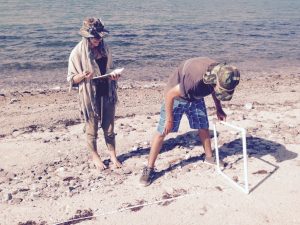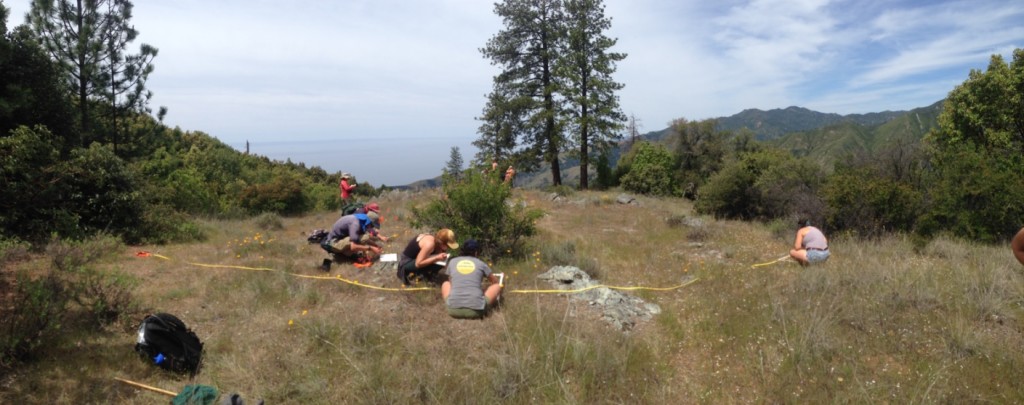 I had the amazing opportunity to TA the Ecology and Conservation field quarter (commonly referred to by students as the Supercourse) from March – June 2016. Not only did I learn an incredible amount of natural history alongside students, but I got to observe two very talented field instructors (Don Croll, UCSC Professor of EEB and Gage Dayton, Director of UCSC’s Natural Reserves) to learn the field teaching ropes that they have perfected over the last 20 years. Now that the the quarter has wrapped up, I have time to jot down a few thoughts on field learning, ecology immersion teaching, and the benefits of teaching natural history alongside ecology theory.
I had the amazing opportunity to TA the Ecology and Conservation field quarter (commonly referred to by students as the Supercourse) from March – June 2016. Not only did I learn an incredible amount of natural history alongside students, but I got to observe two very talented field instructors (Don Croll, UCSC Professor of EEB and Gage Dayton, Director of UCSC’s Natural Reserves) to learn the field teaching ropes that they have perfected over the last 20 years. Now that the the quarter has wrapped up, I have time to jot down a few thoughts on field learning, ecology immersion teaching, and the benefits of teaching natural history alongside ecology theory.
What is the Supercourse?
This course is a field-based, 19-credit course (!) for Ecology and Evolutionary Biology (EEB) and Environmental Studies (ENVS) majors. It is typically taken by juniors and seniors, though open to any students with the appropriate pre-requisites. Students apply and interview for this course, and entry is competitive. Once accepted, the students spend an entire quarter (days, nights, weekends) immersed in ecology, conservation and research in outdoor settings. Last quarter, we spent time at Ano Nuevo Reserve, UCSC Campus Reserve, Landels-Hill Big Creek Reserve and in Baja California Sur on islands in the Gulf of California (the incredible resource that is the UC Natural Reserve System will have to be the discussion of another post). Students design and conduct several field research projects during the course, learning everything from natural history to experimental design to writing and presenting a scientific paper.
Why Supercourse?
Getting students outside to learn science by doing science is a good idea. We know this. Many benefits accrue when students are presented with hands-on learning opportunities in low student-instructor ratio courses. I’m sold on field courses, have a goal of developing and teaching a field course after leaving UCSC, and could write a long blogpost about the many merits of immersion-style teaching. However, instead I want to quickly point out several new things that Supercourse showed me.
Fostering excitement through field learning
Students came into the course clearly burnt out from college lectures, tests, and the competitive nature of the search for internships and research experiences. Students came out of the course excited to attend their next quarter of lectures having seen first-hand how ecology theory and statistics are used in research, eager to put their natural history knowledge to action, and invigorated to seek more research experience. No other time that I have spent with students has yielded such a drastic change in motivation (not to mention understanding of the academic material) in such a short time. Graduating seniors cited the course as the first university experience that has truly showed them what a career in research means, and said that the course provided clarity for their next steps in the field of ecology. Field courses foster excitement for ecology in a major way.
Bringing natural history back to ecology curricula
Throughout the course, students become intimately familiar with the places where they are working – familiarity with a system that one can’t learn from a text book, PowerPoint or video. Students learn the names or plants, the calls of birds, the habits of reptiles. They discover species-area relationships, patterns in the distribution of species, and biophysical feedbacks for themselves. The ecology theory, biological concepts and major paradigms that we teach in the EEB department were largely developed by scientists with a broad and detailed knowledge of natural history. Expecting students to understand these concepts and move into productive ecology careers without a basis in natural history seems crazy. However, you and I both know how dull a lecture on the identification of insects can be. Supercourse provides for a seamless integration of natural history back into the EEB and ENVS curricula (sans lectures), and I think that this alone makes the course incredibly valuable.
Learning stats using data YOU collected
I don’t remember a single thing from my undergraduate statistics course, and have yet to come across a student that is fluent in even simple statistics after AMS 60 (the UCSC undergraduate science-majors stats course). While the goal of Supercourse is not to teach statistics, data management and analysis are woven into the curriculum. Students use statistics on data that they collect, organize, and truly understand and care about. Though not expecting to, every student was conducting t-tests, ANOVAs, and doing linear regressions in JMP by the end of the quarter. This is a major accomplishment! I truly believe that undergraduate programs would be well-served to rethink current statistics requirements for ecology majors and move toward integration of statistics into research-based courses.
Building student confidence
Students begin Supercourse not knowing their classmates, TAs or instructors, having only a vague idea about the experience they’ve signed up for, and for some, having no outdoor or camping experience at all. This course challenges students academically, physically, socially and mentally. And when students come out alive (and successful) at the end of the quarter, the change in confidence is apparent. One of my favorite parts about TAing this course was watching students transition. Many students came to Supercourse uncomfortable with big ideas in ecology, afraid to voice opinions about experimental design, and shy to ask questions for fear of looking silly. By their final Baja projects, the same individuals were engaged in detailed discussions of sample size and how to test major ecological ideas in the desert ecosystem, and were asking me non-stop, interesting questions about natural history, ecology, and data analysis. These students walk out of Supercourse better academically prepared for graduate study, and better physically and mentally prepared for what a career involving field ecology entails.
Equity and diversity in field courses
UC Santa Cruz is a national leader in field immersion courses, and students here benefit immensely from the faculty and staff that have worked to make field courses a priority and reality. However, I feel strongly that we need to continue working to ensure that these courses are widely available. An incredible amount of faculty and staff time, logistics, and supplies go into teaching a field course, and as such, field courses are expensive. Though private donors and universities pick up a large portion of the bill, some of this cost is necessarily passed on to students. In my limited experience, it seems that typically only students with families that are able to cover the bill are able to enroll. Universities and organizations widely acknowledge that STEM fields have a diversity problem (a cultural, racial, gender and economic diversity problem), and finding ways that minority students can take advantage of these field courses should be a priority. These courses give students a competitive research and academic background to move into a job or continue to graduate school, and can be a much-needed tool for retaining minority students in STEM fields.
I left Supercourse with a many-page document of notes on field teaching and the motivation to seek out the experience I need to develop and teach a field course after leaving UCSC. I also left with a renewed excitement for my own research, and renewed dedication to my own development as a natural historian and field ecologist. As it turns out, TAs might just get more out of the course than even students do.
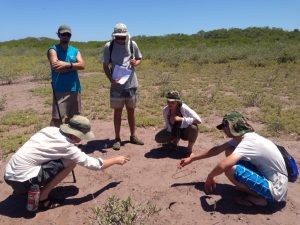 .
. 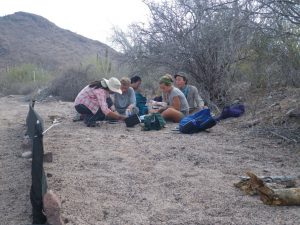
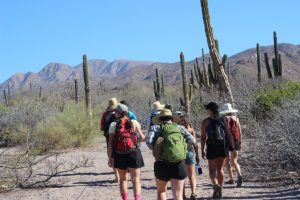 .
. 